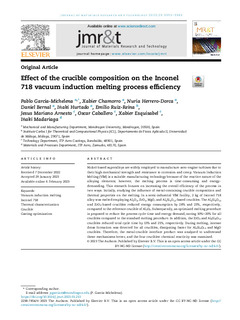| dc.rights.license | Attribution-NonCommercial-NoDerivatives 4.0 International | * |
| dc.contributor.author | Garcia-Michelena, Pablo | |
| dc.contributor.author | chamorro, xabier | |
| dc.contributor.author | Herrero-Dorca, Nuria | |
| dc.contributor.author | Bernal, Daniel | |
| dc.contributor.author | Hurtado, Iñaki | |
| dc.contributor.other | Ruiz-Reina, Emilio | |
| dc.contributor.other | Mariano Arnesto, Jesus | |
| dc.contributor.other | Caballero, Oscar | |
| dc.contributor.other | Esquisabel, Xabier | |
| dc.contributor.other | Madariaga, Iñaki | |
| dc.date.accessioned | 2023-03-13T09:23:17Z | |
| dc.date.available | 2023-03-13T09:23:17Z | |
| dc.date.issued | 2023 | |
| dc.identifier.issn | 2214-0697 | en |
| dc.identifier.other | https://katalogoa.mondragon.edu/janium-bin/janium_login_opac.pl?find&ficha_no=171706 | en |
| dc.identifier.uri | https://hdl.handle.net/20.500.11984/6038 | |
| dc.description.abstract | Nickel-based superalloys are widely employed to manufacture aero-engine turbines due to their high mechanical strength and resistance to corrosion and creep. Vacuum Induction Melting (VIM) is a suitable manufacturing technology because of the reactive nature of the alloying elements; however, the melting process is time-consuming and energy-demanding. This research focuses on increasing the overall efficiency of the process in two ways. Initially, studying the influence of metal-containing crucible composition and thermal properties on the melting. In a semi-industrial VIM facility, 2 kg of Inconel 718 alloy was melted employing Al2O3, ZrO2, MgO, and Al6Si4O13-based crucibles. The Al6Si4O13 and ZrO2-based crucibles reduced energy consumption by 28% and 23%, respectively, compared to the reference crucible of Al2O3. Subsequently, an optimized melting procedure is proposed to reduce the process cycle time and energy demand, saving 10%–20% for all crucibles compared to the standard melting procedure. In addition, the ZrO2 and Al6Si4O13 crucibles reduced total cycle time by 13% and 21%, respectively. During melting, intense dross formation was detected for all crucibles, dissipating faster for Al6Si4O13 and MgO crucibles. Therefore, the metal-crucible interface product was analyzed to understand these mechanisms better, and the four crucibles' chemical reactivity was examined. | en |
| dc.description.sponsorship | Gobierno Vasco-Eusko Jaurlaritza | es |
| dc.language.iso | eng | en |
| dc.publisher | Elsevier | en |
| dc.rights | © 2023 The Authors | en |
| dc.rights.uri | http://creativecommons.org/licenses/by-nc-nd/4.0/ | * |
| dc.subject | Vacuum induction melting | en |
| dc.subject | Inconel 718 | en |
| dc.subject | Thermal characterization | en |
| dc.subject | Crucible | en |
| dc.subject | Casting optimization | en |
| dc.subject | ODS 7 Energía asequible y no contaminante | es |
| dc.subject | ODS 9 Industria, innovación e infraestructura | es |
| dc.title | Effect of the crucible composition on the Inconel 718 vacuum induction melting process efficiency | en |
| dcterms.accessRights | http://purl.org/coar/access_right/c_abf2 | en |
| dcterms.source | Journal of Materials Research and Technology | en |
| local.contributor.group | Procesos avanzados de conformación de materiales | es |
| local.description.peerreviewed | true | en |
| local.description.publicationfirstpage | 3351 | en |
| local.description.publicationlastpage | 3361 | en |
| local.identifier.doi | https://doi.org/10.1016/j.jmrt.2023.01.213 | en |
| local.relation.projectID | info:eu-repo/grantAgreement/GV/Elkartek 2020/ZE-2020-00001/CAPV/Faktoria/FAKTORIA | en |
| local.rights.publicationfee | APC | en |
| local.rights.publicationfeeamount | 1300 USD | en |
| local.contributor.otherinstitution | https://ror.org/036b2ww28 | es |
| local.contributor.otherinstitution | ITP Aero Casting | es |
| local.source.details | Vol. 23 | en |
| oaire.format.mimetype | application/pdf | |
| oaire.file | $DSPACE\assetstore | en |
| oaire.resourceType | http://purl.org/coar/resource_type/c_6501 | en |
| oaire.version | http://purl.org/coar/version/c_970fb48d4fbd8a85 | en |








